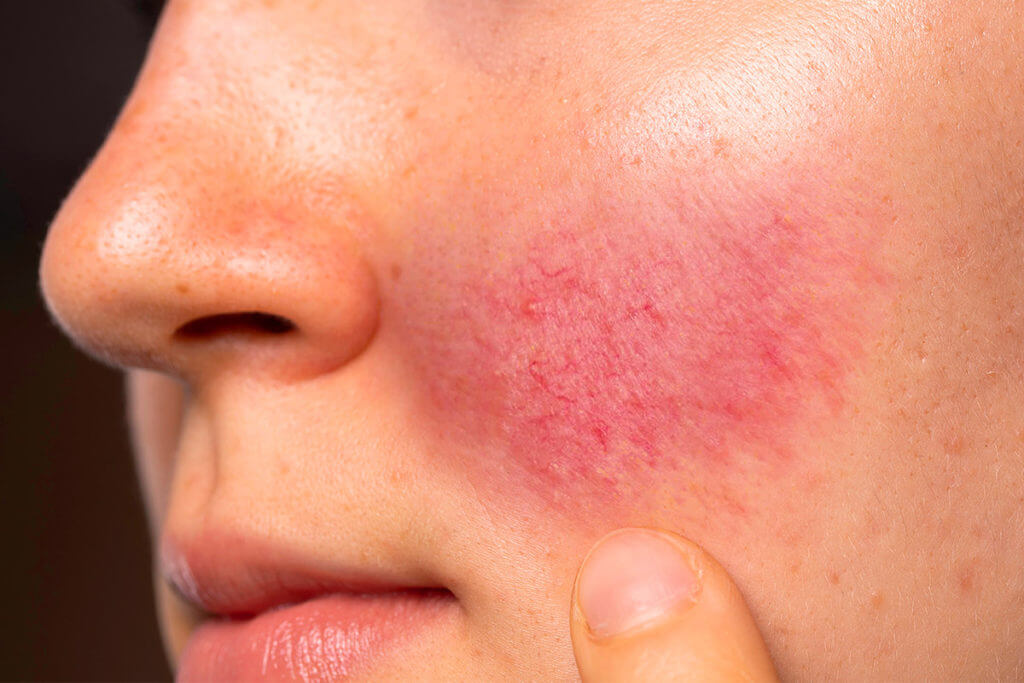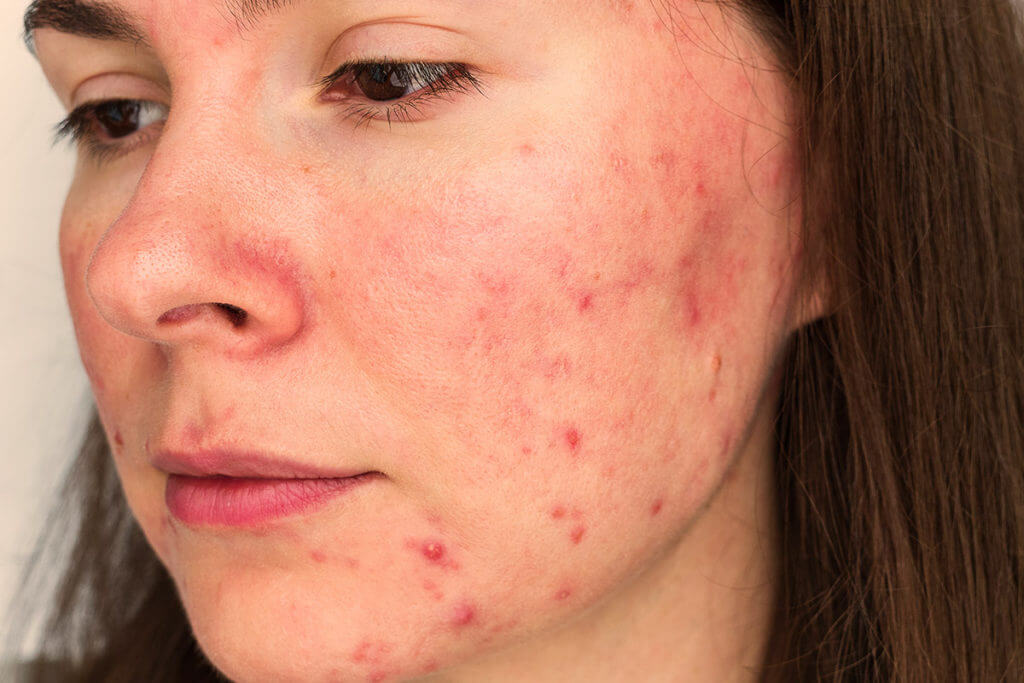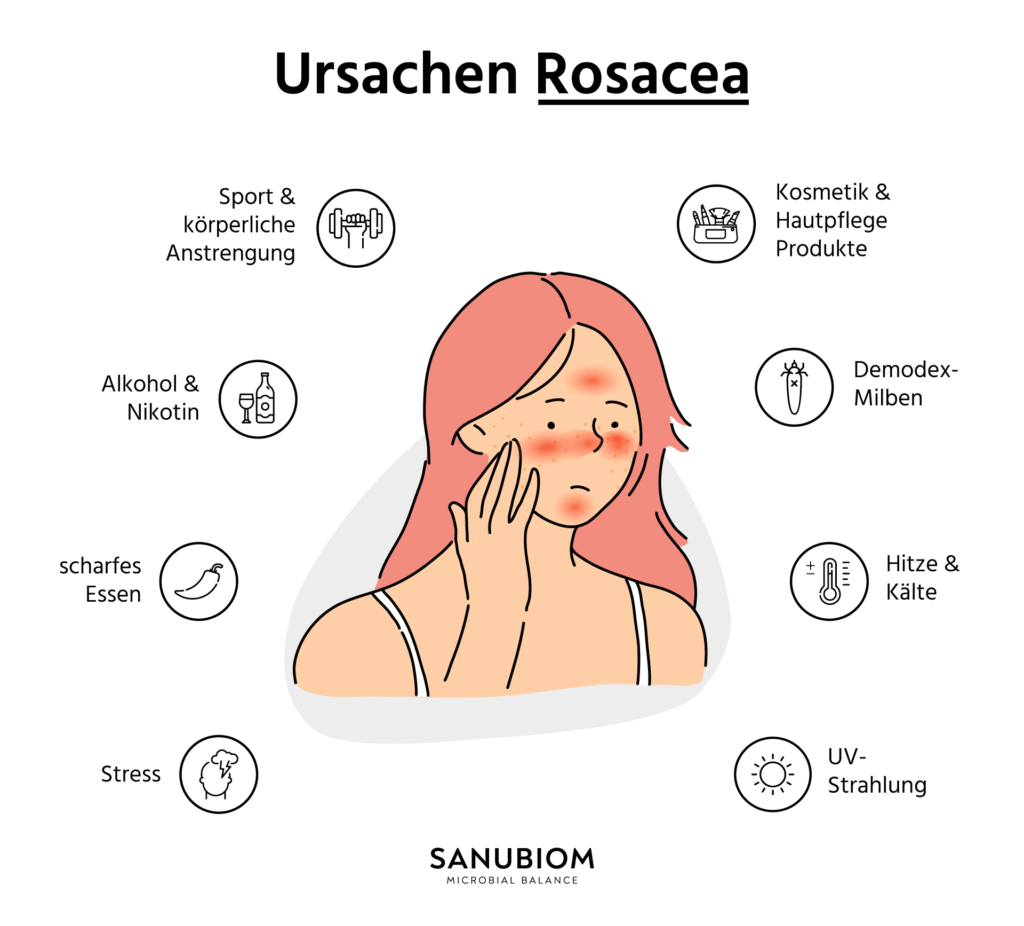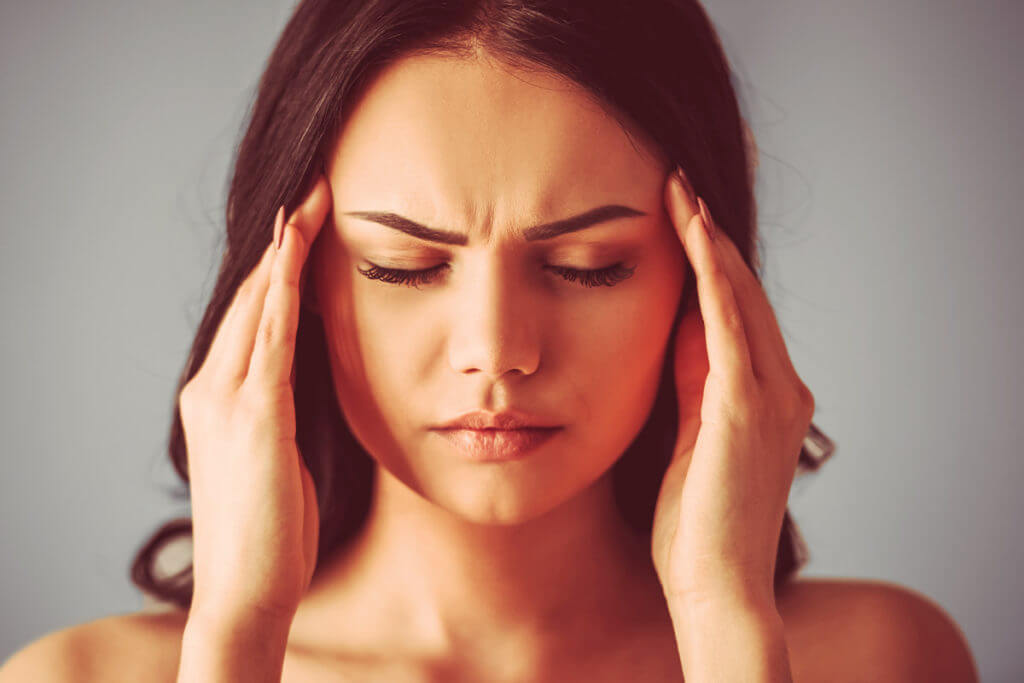
Rosacea (or copper rose) is a skin condition that is accompanied by typical redness on the face. It is often compared or even confused with acne.
The skin disease is typically characterized by inflammation and redness on the nose, eyes, mouth and cheeks. Compared to acne, rosacea can also be accompanied by itching.
In Germany alone, around 10 million people suffer from the disease. The associated chronically inflamed facial skin is particularly sensitive in those affected.
Because of these and other complaints, many sufferers are looking for information, education and rapid relief. However, as with so many skin conditions, patience is also required for treatment.
In this article, we take a closer look at how the disease progresses and how you can support your skin.
SKINCARE PROTECT
Probiotic skin protection SkinCare Protect with Phage Technology.
Your skin comes to rest.
Rosacea is a non-contagious skin condition that particularly affects the face, especially the cheeks and nose. This skin disease is associated with chronic inflammation. This means that the affected areas are reddened.
This redness usually occurs in episodes at the beginning until it manifests itself at some point. As the disease progresses, the fine blood vessels (capillaries) of the facial skin become dilated.
Later, blisters and nodules reminiscent of acne can form.
In men in particular, advanced growths form in the nose area. Rather rarely, it is a special form of the disease that also affects the eyes.
Due to the reddening of the face and the blisters that develop later, rosacea acne is sometimes also referred to as senile acne.
This is because it usually appears between the ages of 30 and 50. However, this term is misleading, as the blackheads typical of acne are absent in rosacea acne.
In rare cases, however, the condition may occur together with acne – a mixed form of the two conditions may then be present.

It is mostly middle-aged people who are affected by Kuferrose for the first time. Symptoms often appear for the first time between the ages of thirty and fifty. Women tend to be affected slightly more often than men, but this difference is not too significant.
Light skin types in particular are also more likely to fall ill. Of course, there are always exceptions. If rosacea is suspected based on the appearance of the skin, a dermatologist can check whether the disease is present.
Even if it is less likely, rosacea can also occur suddenly in children or adolescents.
The redness – the typical rosacea face– is particularly noticeable in the course of the disease. These visible veins are usually found in the cheek area or appear as a nodular thickening of the nose. They are an indication of the chronic inflammation caused by the disease.
As the disease progresses, the vessels of the facial skin can be recognized as a fine network on the affected areas of skin. The vascular dilatations become visible as they are widened by the skin disease.
Later, blisters and nodules also appear on the cheeks, nose, chin and forehead. These inflammations of the skin can sometimes be mistaken for acne, as they are very similar.
Apart from the external appearance, there are other symptoms that suggest rosacea. There may be episodes in which the redness is particularly visible. These flare-ups are caused, for example, by certain foods, heat or sunlight.
The skin also reacts sensitively to environmental influences or care products. It is then irritated, burns or itches and is sensitive to touch. The skin may be dry or flaky.
Couperose, also known as copper rose, is often seen as an early form of rosacea. In contrast to chronic inflammatory skin disease, couperose is not a disease. Typical symptoms are reddening of the facial skin due to a genetic dilation of the blood vessels. These are temporary and may subside.
As with rosacea, the redness is accompanied by sensitive, dry, possibly itchy skin and dilated blood vessels.
The first phase, also known as the preliminary stage of rosacea, is characterized by fleeting reddening of the skin (erythema). This sudden reddening of the face is also known as a flush. The cheeks, nose, chin and the middle of the forehead are mainly affected. The symptoms usually go away on their own, just as quickly as they came.
In severity grade 1, also known as rosacea erythematosa-teleangiectatica, the reddening of the skin is accompanied by vascular dilatation (telangiectasia). Those affected suffer from dry and flaky skin. Itching and stinging skin pain can also occur.
Rosacea papulopustulosa is the next most severe form of the disease. This stage is characterized by blisters and nodules that form in addition to the previous rosacea symptoms.
The symptoms, also known as pustules and papules, can subside under certain circumstances, but patience is required – this often takes several weeks.
Glandular hyperplastic rosacea is the most pronounced form of the disease. Men in particular suffer from this degree of severity. The connective tissue and the sebaceous glands in the face can sometimes become greatly enlarged.
This manifests itself in growths, also known as phyma, on the face. Mostly affecting the sebaceous glands around the nose, this results in the characteristic rosacea nose, also known as a bulbous nose (rhinophyma).
Rosacea fulminans is a special form of the disease. This form is the maximum variant of this skin disease. It occurs exclusively in young women.
An increased occurrence can be heard after pregnancy. Symptoms of this special form are seborrhea, which is accompanied by skin blemishes such as pimples and pustules.
Why do you have rosacea? Although many people suffer from it, its exact causes are not yet fully understood. However, there are various assumptions: There may be genetic reasons.
Lifestyle can also have an influence. In particular, frequent contact with strong UV radiation and regular alcohol consumption are the focus here. Disturbed intestinal flora is also a possible cause.
Another possibility is that the chronic inflammation could also be a reaction of the immune system. This misguided reaction may be innate.
Antimicrobial substances, which are actually intended to defend against pathogens, are present in excess in the skin of those affected. This can be due to the triggering of inflammation, for example.

In addition, a certain type of mite, the Demodex mite, was found in increased numbers on the skin of those affected. A possible connection is also assumed here.
These tiny animals, also known as hair follicle mites, may well contribute to triggering the immune system reaction described above.
Another possibility: nerves in our face control the dilation and contraction of the fine blood vessels. If these nerves are inflamed, this control system no longer functions properly. Once dilated, for example by heat or other triggers, the blood vessels no longer contract properly.
There are several factors that can exacerbate the symptoms or trigger flare-ups of the skin disease. These include, for example
We would like to take a closer look at some of these factors. Knowing these and avoiding them as far as possible can be a great relief for patients.
UV radiation promotes a wide variety of skin irritations and diseases, including rosacea. Strong sunlight causes the symptoms to worsen.
You should therefore avoid strong sunlight, especially in summer, as well as sunbeds. The skin can be protected from damage with the right sunscreen.
It is therefore advisable to use a high sun protection factor of 50+ all year round and every day. Many people find it difficult to choose the right sun protection for everyday use, but the search is definitely worthwhile.
A distinction is made between mineral and chemical sunscreens. Mineral filters are sometimes better tolerated, but always have a more or less strong whitening effect.
Find out more in our article:“Sun protection – you should pay attention to this!“

Stress is also an important factor that can exacerbate the symptoms of copper rose. Apart from the small and large hurdles of everyday life, it is often the illness itself that causes stressful situations. Conscious relaxation in the form of yoga, meditation or autogenic training can help to achieve a better balance in stressful everyday life.
As relaxation and stress reduction are very individual topics, you can find your own individual way of dealing with stress. This could also be reading a book in the evening or cooking your favorite dish.
The very sensitive facial skin caused by rosacea can be easily irritated by skin care or decorative cosmetics. Ingredients such as camphor and menthol, essential oils, fragrances or alcohol can potentially intensify the symptoms.
For many of those affected, it is a must for cosmetic reasons to conceal the existing redness for the day with decorative cosmetics.
When choosing the right make-up, you should also pay attention to the basic ingredients – i.e. no irritating fragrances or alcohols and not too heavy a consistency. Products with high coverage in particular can be too heavy on the skin.
Ideally, the sebaceous glands are not blocked by make-up. However, the comedogenic, i.e. potentially pore-clogging, properties of products vary from skin to skin and should be carefully observed.
As a guide: there is also special rosacea make-up. In addition to a classic concealer or foundation, there are also special green pigmented products. These are applied as the bottom layer and can neutralize particularly severe facial redness.
When choosing suitable cosmetics, a few principles can be observed. Nevertheless, every skin reacts individually to different products.
That’s why you should only gradually integrate new products into your routine. If the skin reacts negatively, this makes it easier to determine which product this reaction is associated with.
Can rosacea be cured? In principle, the skin disease cannot be cured, even if the chronic course of the disease can be halted in some cases. Nevertheless, there are various ways to manage the symptoms and live well with the skin condition.
The first step is usually professional counseling or treatment with medication. Treatments in the form of ointments and gels that are applied externally are particularly popular. Good results have been achieved with azelaic acid and the antibiotic metronidazole.
Both have an anti-inflammatory effect and may have a controlling influence on the active immune system in the facial skin. Antibiotics are also used for copper rose, but can lead to undesirable side effects. Homeopathic remedies can also be used for mild cases.
Accordingly, they are used to treat the typical redness. Once again, patience is important. The treatment takes place over a long period of time and it takes a while for the first successes to become visible. Other active ingredients are used to treat nodules, papules and pustules.
If the blood vessels are already very dilated and the rosacea is advanced, laser treatment can also be used. Sclerotherapy with electricity is also an option, as are surgical methods.
In addition to the dermatologist’s treatment options, those affected can avoid the possible triggers of the symptoms described above.
Diet can also play a role. Patience and careful observation are again required here. Reducing fat and sugar in the diet can help many people, while others react sensitively to dairy or animal products in general.
Again, this is very individual and therefore there is no universally effective diet. For a healthy gut, however, it is important to provide it with a healthy diet. This is because intestinal health has an effect on the skin.
Be careful with home remedies, these are best discussed with your dermatologist first. It is advisable not to diagnose rosacea on your own. However, if home remedies are used correctly, they can help to alleviate the symptoms.
The cause is often a disturbed bacterial balance of the skin. In this case, the disturbed microbiome can be improved again with natural bacteria.

The basis of rosacea care is thorough but gentle cleansing. Soaps are not suitable for this, as their alkaline pH value can destroy the skin’s protective acid mantle. It is better to use washing lotions or syndets with a pH value of 4.5 to 5.5 . These are much gentler.
The water itself also plays a role in cleaning. The use of lukewarm water is ideal. Too hot or too cold would encourage rosacea redness. If the hardness of the water is too high, this can also be counterproductive.
If you want to try out the “double cleansing” trend when cleansing your skin, you should listen carefully to your skin. Oil is used for the first cleansing step and a gel or lotion for the subsequent cleansing step.
Because as important as thorough cleansing of the skin is, too much can also irritate the skin.
A tip for the right skin care for skin with make-up: The most thorough and gentle way to cleanse it is with a special oil cleanser. The oil content reliably removes make-up without a lot of rubbing. On contact with water, the emulsifiers ensure that the product can be rinsed off without leaving any residue.
Mechanical exfoliation should be avoided in the case of rosacea, as should vigorous rubbing with a towel. Both can be very irritating to the skin. Light creams and lotions that are not too heavy on the skin but still moisturize it are suitable for skin care. Glycerine and silicone oils are often well tolerated as ingredients.
The desired sunscreen should always be used at the end of the morning skin care routine to reduce UV radiation as a trigger for symptoms. If you add decorative cosmetics, you can apply them about 10 – 15 minutes after sun protection.
You can find more tips here:“The right skin care for rosacea – 10 tips“
Rosacea is often associated with a disorder of the skin barrier. Unfortunately, this also makes the skin more susceptible to irritation of all kinds. Keeping this barrier healthy and intact is therefore important for many skin conditions – not just rosacea. It is not for nothing that the microbiome and the bacterial balance of the skin are now frequently mentioned.
The microbiome refers to the composition of bacteria, viruses and fungi on and in our bodies. A distinction is made between “good” and “bad” bacteria, i.e. those that damage the skin and those that protect it through their activities. For example, some bacteria produce proteins that kill germs.
If the microbiome is disturbed, the natural balance is no longer maintained due to an excess of “bad” bacteria and this also damages the barrier.
That is why there are probiotic skin care products, for example, to support and restore this balance. These promote the growth of bacteria that are beneficial for our skin.